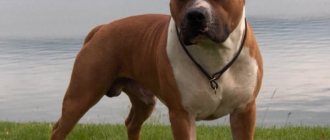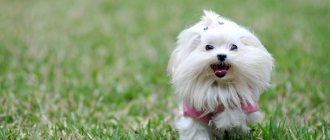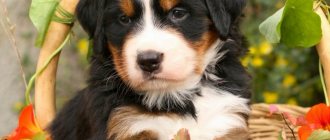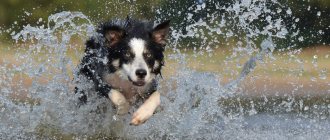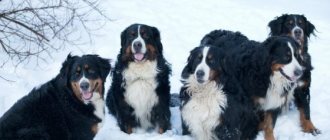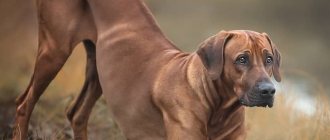Brief characteristics of the breed
- Other possible names: Greater Swiss Dog, Berner Sennenhund, Bernese Mountain Dog, Bernese Cattle Dog.
- Adult height: for a male the norm is from 64 to 70 cm, for a female from 58 to 66 cm.
- Weight: an adult male weighs 39-50 kg, a female 36-48 kg.
- Characteristic color: tricolor with a predominance of black.
- Coat length: long, thick.
- Lifespan: The Bernese Mountain Dog lives on average 7-9 years.
- Advantages of the breed: loyal, kind, fearless, loves children.
- Difficulties of the breed: it requires coat care, is susceptible to many genetic diseases, does not tolerate heat well.
- Average price: Bernese Mountain Dogs range from $300 to $1,500.
Bernese Mountain Dog diseases
The good news is that the breed has excellent heredity, but improper maintenance can lead to some problems. Many people are interested in how long Bernese Mountain Dogs live. On average, this period is 9 years. There are representatives who, with good care, celebrated their 13th birthday. The most common diseases are:
- joint dysplasia;
- osteochondrosis of the shoulder;
- eye problems;
- the Greater Bernese Mountain Dog sometimes suffers from alopecia;
- umbilical hernia;
- hereditary kidney disease.
History of the breed
According to some historical texts, large dogs resembling the Mountain Dog appeared in the mountains of Switzerland as early as the 1st century AD. This happened during the conquest of the western part of the country by the Roman Empire, which at that time was called Helvetia. The legionnaires brought with them their dogs - Roman Molossians, some of which were lost in the Alps.
During excavations of a Roman legionnaires' camp at the end of the 19th century, the remains of dogs were found that were identical to those of today's Berners. According to ancient Roman and ancient Greek writings, Molossians came to Rome from Greece, to which they were brought from India. They appeared in India due to its proximity to Tibet.
Thus, the Bernese Mountain Dog is the ancestor of the Tibetan Great Danes, crossed with the Roman Molossians, and then with the Central European Great Dane. Swiss shepherds and peasants appreciated the working qualities of these dogs, which became their indispensable helpers.
In the second half of the 15th century, the breed could disappear without waiting for its recognition. This was almost facilitated by the decree of the burgomaster of the city of Zurich, which he issued in 1489.
According to the decree, all large peasant dogs that allegedly spoiled the vineyards of local aristocrats were to be destroyed. The reaction of the people was immediate: a peasant uprising was organized, during which the burgomaster was overthrown from his post and his head was cut off.
The year 1892 can be considered the beginning of the purposeful breeding of the Bernese Mountain Dog. This was facilitated by winemaker from Burgdorf F. Schertenleib, who bought several dogs from different areas. He would later become one of the founders of the Bernese Mountain Dog show classes.
So, since 1904, the breed was published and took its first steps towards recognition among the Swiss. Until this point, dogs were considered large peasant mongrels.
In 1907, the “Central leaflet for lovers of hunting and dogs” was published, where a description of the dog known to us as the Bernese Mountain Dog was published, which was accepted as the first standard of the breed. Until 1910, it had a different name - Dürrbahler.
In 1949, by chance, the Berner was joined by the blood of a Newfoundland, which entered the territory of the nursery. The breeders liked the long-haired babies that were born, black in color with a white chest and paws, as well as with rare fawn accents. This is how the breed received a modern look and a new standard, which was officially adopted in 1973.
In 1993, the breed was recognized by the FCI and the final adjustments to the standard were published. The new breed of large tricolor dogs quickly won the hearts of dog lovers in Austria, Switzerland and Germany. Currently, burners are popular in many European countries, as well as in the USA and Canada.
History of the origin of the breed
Greater Swiss Mountain Dogs are more than two thousand years old. Their ancestors were supposedly large mastiffs that came to the Alps with the Roman conquerors. Of all four types of Mountain Dogs (Bernese, Swiss, Appenzeller and Entelbuch), the Swiss is considered the oldest and largest breed.
Some believe that this is a failed selection of the Bernese Longhair. But in fact, everything is quite the opposite. It was to the Gross that the blood of other breeds was grafted. And after the Bernese Mountain Dog was recognized as a separate breed in the 19th century, breeders began to select the largest smooth-haired dogs with large heads, of which there were not many left by that time.
Unfortunately, the further development of the breed occurred mainly through inbreeding (crossbreeding between direct relatives), which somewhat weakened the health of the dogs.
Initially, the breed was called the “smooth-haired Bernese Mountain Dog” and under this name even took part in an exhibition that took place in Langenthal in 1908. But already in 1912, the Greater Swiss Mountain Dog Club was founded, which took control of the further breeding of such dogs.
The residents of Switzerland loved these dogs so much that even outbred puppies were sold outside the country for a lot of money. They gained such popularity thanks to the story about one representative of the breed, whose name was Barry. He lived at the monastery and once, thanks to his instincts, saved forty monks from certain death.
In 1939, the breed officially received recognition from the Federation Cynologique Internationale (FCI) . Until 1956, the Swiss remained red with white accents on the chest, paws and head. They were then crossed with Berners, which by that time were already tri-colored thanks to the intervention of the Newfoundland. This is how the familiar, bright and recognizable color of large Swiss dogs appeared.
Purpose of the breed
For many centuries, Bernese Mountain Dogs were destined to herd flocks in the vast Alpine meadows. Their large stature and stern, frightening bark made them excellent watchmen and security guards. Peasants often used strong Berners as draft and sled dogs.
Currently, the breed continues to perform its duties in some areas of Switzerland and serves in mountain rescue teams. You can often meet representatives of Swiss Shepherds on film sets. Most often, such dogs are adopted as companions and big four-legged friends.
Characteristics of the Bernese Mountain Dog breed
They are large , friendly and cheerful dogs. They express their love and good nature for people and the world around them in their delightful smile. Berners easily get along with any family and quickly capture the hearts of their owners.
They are incredibly loyal and strongly attached to people, so they have a very hard time withstanding separation and loneliness. For this breed, a change of owners is undesirable , which can cause prolonged apathy and depression.
their highly developed herding instinct to their family. This is especially true for children and pets. Even while frolicking and playing, the dog does not forget to monitor the safety of its “herd”. A small child can be safely left in the care of this caring and attentive nanny. The dog will not only not offend the baby, but will also protect him in every possible way.
It is very difficult to lose sight of such a pet, since it should always be with its family. Although they are a strong, working breed, Berners do not require much exercise and are not very fond of it. After running around a bit, they will happily take a leisurely stroll along the park’s alleys next to the owner.
Berners are obedient and try in every possible way to please their owners. But there may be some difficulties in learning. They will need a little more time to absorb information and remember commands.
Description of the nature of the breed
Incredibly loyal and good-natured, Great Swiss Mountain Dogs are very intelligent and obedient. But if they don’t want something, then no amount of persuasion or motivation will help. Despite their kindness, these dogs are able to scare away any intruder by warning him with their massive bass voice. They are wary of all strangers, but as soon as the owner shows joy when meeting a guest, the dog will begin to caress himself, wagging his tail welcomingly.
They show respect and their canine love to the whole family and treat children with tenderness. But when they get too playful, they can accidentally push the baby, so it’s better to keep an eye on their fun. Greater Swiss Mountain Dogs remain playful teenagers for a very long time, even if they appear to be mature and important dogs. This is due to the fact that the process of physical and moral formation is somewhat delayed for them.
Grosses have a stable psyche. They are calm and balanced and do not have mood swings. They can calmly observe others for a long time and cannot stand loneliness.
How to choose a puppy
It is better to purchase a puppy at the age of two to three months. By this age they are already quite strong and independent. Until almost three weeks of age, all Berner babies, without exception, are deaf and blind. During this time, they actively develop other ways of perceiving the outside world.
Breeders try not to miss the moment when hearing and vision appear. This time plays an important role in initial socialization and the formation of future character. If a puppy is frightened by a loud noise or sees something unpleasant, it can grow up to be a fearful dog. Therefore, immediately pay attention to the living conditions of the litter.
As for the puppies themselves, they should resemble moderately well-fed, strong bear cubs with thick paws and massive bones. Kids should be active, friendly, not afraid of people and not crouch or hide from loud and sharp sounds.
The gait of young Berners, as a rule, is sweeping and mincing is completely excluded. a close look at the paws. Puppies should not bend their legs when walking or limp. When choosing a devoted companion and a favorite for the whole family, trust your inner instinct, which will not let you down.
Hereditary diseases are common in dogs of this breed, and all Bernese Mountain Dog puppies are subject to a thorough medical examination from birth. For this reason, you should not chase a cheap price. It would be more advisable to contact experienced breeders or a nursery. If you end up taking your pet from your hands, don’t delay your visit to the veterinarian. This way you can avoid many future problems.
Dog names
No matter how small and fluffy the little ones were in childhood, do not forget that in the future they will grow into a majestic, powerful and noble dog. So immediately choose an appropriate nickname for him, so that you don’t have to clumsily call a big dog Fluffy.
For boys of this breed, nicknames such as Bayard, Baron, Gross, Porthos, Nord, Frant, Junker and the like may be suitable. a girl Abba, Bertha, Blackie, Kelly, Frau, Holly and so on.
Care and maintenance of the Bernese Mountain Dog
The main thing in caring for a shaggy Berner is not to leave the fur, which quickly becomes tangled and clumps. To prevent this from happening, you should comb it at least three times a week with a special comb.
This is not difficult to do if you learn to take it with you for a walk. If you still haven’t followed through and the fur has become matted, then use a spray or other means to facilitate this process when combing. Too tangled tufts are carefully cut out.
The problem is that these dogs shed all year round, so they are not very suitable for apartment living. Moreover, thick wool can keep them warm in the cold and frosty seasons. Berners feel even better in this weather, and they can hardly tolerate the heat.
It would be correct to keep the dog in a private home, with the opportunity to move freely around the territory. And also make her a ventilated enclosure with a spacious booth.
Some owners cut their pets' hair in the summer. Grooming a Bernese Mountain Dog can be done independently or with the help of a specialist. Treat periodically for fleas. It is also necessary to monitor the condition of the eyes and ears.
Training a Bernese Mountain Dog
In order for the pet's character to be formed correctly, it is important to carry out timely education of the Bernese Mountain Dog. Dog handlers recommend starting socialization of your pet as early as possible so that it reacts correctly to the people and animals around it. Despite its impressive appearance, the Bern is very vulnerable, so you should not use physical punishment or shouting in your education. In training, it is important to show firmness and perseverance, to point out mistakes in a stern tone, but no more.
The stages of training a Bernese Mountain Dog include:
- 2 months
– accustom to a leash and muzzle. Only with them you can walk your dog in public places. - 3 months
– carry out socialization, walks should be short. - 4-5 months
- a time of disobedience and testing everything by the tooth. To show your puppy not to bite your hands, you need to lightly pinch his nose. Start learning simple commands. - 6 months
– the second stage of growing up, you need to take into account all the mistakes and try to quickly correct them.
Possible health problems
Unfortunately, the Greater Swiss Dog does not live long and has a number of hereditary diseases. Among them:
- Dysplasia of the fore and hind limbs. The presence of this disease becomes clearly visible by six months. Lameness and joint pain appear. It is considered an incurable disease, but vitamin supplements and medications can significantly slow down its progression.
- Eye diseases, including entropion and eversion of the eyelids, progressive cataracts, conjunctivitis.
- Kidney pathology. It is detected only during tests and ultrasound.
- Malignant hysteocytosis. In other words, spinal cancer. Any carcinogens should be excluded from the dog's diet.
In addition, weeping eczema may occur, which appears from stress, poor grooming and insect bites, in particular ticks. It is also not uncommon for Berners to suffer from heatstroke during the hot season.
Proper care, balanced nutrition, sufficient exposure to fresh air and timely and, if possible, regular visits to a veterinarian will help reduce the risk of health problems.
Do not neglect the prevention of parasites such as worms. And also do not violate the vaccination schedule. The Bernese Mountain Dog requires careful attention, which often determines how long they will live, delighting their owners with their beauty and good nature.
Nutrition for puppy and adult dog
The diet of the Bernese Mountain Dog can consist of dry, natural or mixed food. not recommended on dry food . A low-quality product can significantly damage your pet's health.
Natural feeding of Berners is no different from feeding other large dogs. It includes meat and offal, cereals, sea fish, dairy products, as well as fresh vegetables and fruits. Any smoked meats, low-quality sausages and fatty foods should be completely
Up to five months of age, a puppy should be fed four times a day. Then transfer to three meals a day, and when closer to a year, feed twice a day, like an adult dog. For a puppy up to one year old, during the formation of teeth and bones, it is recommended to include cottage cheese in the diet once a day. The dog should have a bowl of water. This is especially true in the summer.
Gross Mountain Dog Care
Caring for a Gross Mountain Dog has practically no special features:
- The coat is combed once a week with a stiff brush; during the molting period (twice a year), the procedure is carried out 2-3 times a week.
- The ears and eyes are checked daily, and cleaned: ears once a week or when dirt is detected; eyes every morning with a cotton pad moistened with boiled water.
- Claws are trimmed as they grow (in pets that are actively walked, they grind down on their own). Paws are washed after each walk with water without using detergents, thoroughly removing dirt between the toes.
By definition, this dog cannot be a decoration for the sofa. She needs to move. Therefore, the pet will need at least two walks a day for an hour. On weekends, it’s good to go with the dog to the forest, park, field, where he could frolic to his heart’s content. You can involve your pet in any type of dog sport; intelligence and endurance will help the gross master everything that is required of him.
Regular training will help keep your pet's muscle corset in good shape.
Feeding
Feeding large breed dogs requires special attention. If there is a lack of nutrients, problems with the skeletal system and joints may occur. This is especially important during puppyhood, which is characterized by rapid growth.
In this sense, a high quality industrial diet (super premium or holistic classes) is preferable. It has a balanced composition and will cover the need for all essential vitamins and minerals. Foods are selected for large breed dogs:
- Genesis Pure Canada Grand Prairie Adult;
- NOW Fresh Large Breed Grain Free;
- Summit Holistic Original Three Meat, Large Breed Recipe DF;
- Savarra Adult Dog Large Breed;
- Almo Nature Holistic Adult Dog Large & Lamb.
The Gross Mountain Dog requires quality nutrition.
If the pet is on a natural diet, the owner needs to make sure that it mostly consists of lean meat. It is given raw, cut into cubes and scalded with boiling water. In addition to meat, the diet includes:
- offal (pre-boiled);
- cereals - boiled with vegetables and herbs, seasoned with vegetable oil;
- fruits (except grapes) - some dogs love them and eat them with pleasure;
- fermented milk products - cottage cheese, yogurt, kefir.
Additionally, bone meal is added to the food or a vitamin and mineral complex recommended by a veterinarian is given.
Puppies are fed 6 times a day, gradually reducing the number of feedings to 2 by the year.
Training and education of the Bernese Mountain Dog breed
Training a Bernese Mountain Dog will require a little more time and patience than many other large dog breeds. It would be wrong to call them stupid. Berners try hard to meet the demands of their owners. But they need a longer period to perceive and remember information.
Daily repetition, endurance and perseverance will help you achieve excellent results. Moreover, these dogs are very obedient. It would be a good idea to take your pet through a special training course under the guidance of a specialist. When keeping a dog indoors, teach it to be clean from an early age.
Bernese Mountain Dog – interesting facts
Facts will help you get to know the animals of this breed even better:
- The Bernese Mountain Dog breed may have been exterminated at the end of the 14th century.
- During the peak of the dogs’ popularity, people came to Switzerland from other countries and paid considerable money to buy them.
- The breed has two officially confirmed names: Dürbachler and Bernese mountain dog.
- Berns had a mystical image because of their fur. In ancient times, people believed that the tan in the form of a second pair of eyes helped the Berns to act as a mediator between them and God.
- During the war, these shepherds helped move weapons and worked as signalmen and miners.
- If a dog living in a village is left unattended, there is a chance that, following his natural instincts, he will drive a whole litter of different animals into the yard.
Advantages and disadvantages
If you need a faithful and devoted friend, from communication with whom you will only have positive emotions, get a Bernese Mountain Dog. These balanced and good-natured aristocrats, in addition to their excellent character, also have a charming color. Along with calico cats, Berners are believed to bring happiness to the home.
Dogs of this breed are suitable for absolutely any family . They also treat strangers peacefully. But if danger arises, they will bravely and fearlessly defend their family and territory.
It is difficult to find a breed more attached to humans. Berners are always nearby. And if a child comes under their care, then you don’t have to worry about the baby’s safety. The dog will play with him, support him during the first steps, and also “graze” without taking his eyes off him.
If you are a lover of quiet walks, then this breed is also suitable for you. Berners are not keen runners and do not require large, long periods of exercise. Despite their strength and endurance, they are lazy dogs and will be reluctant to keep you company while jogging or cycling. They feel more comfortable lounging at your feet, although they are also not averse to frolicking occasionally.
In winter, your shaggy pet will happily roll around in the snow and take you on a sled ride. The difficulty in keeping Berners is that they need to be given a lot of attention. Without human interaction, they do not feel happy and may become depressed.
Large Swiss dogs shed year-round and require daily grooming. Therefore, they are more suitable for keeping in a private home. Due to the difficulty in perceiving information, difficulties may arise when learning.
Their health should be closely monitored, as the Bernese Mountain Dog is very susceptible to many hereditary diseases and has a low life expectancy. Having given your pet love and affection and surrounded him with care, it is hardly possible to find a more devoted dog.
Reviews
Elizabeth:
My handsome guy's name is Jack. This breed should have been called “I’ll Be Around.” He doesn’t move a step, somehow managing not to get in the way. Neat. I quickly got used to doing all my business outside. By the way, he loves to walk. Not to run around like other dogs, but to walk. It seems that a little more and he will take your hand.
When his sister and his little nephew come to visit, Jack does not take his eyes off him and does not leave him. Allows himself to be bullied. We learned quickly and without dog handlers. While growing up, I ate a lot. And now like all big dogs. If you choose a dog for your home and family, then only this one.
Ruslan:
Our Bernese girl lived with us for 8.5 years. To briefly describe the character, it is calmness, kindness and devotion. She didn’t bark over trifles and treated strangers absolutely calmly. We took a training course. The dog handlers were surprised at how quickly she grasped everything.
What I couldn’t learn was to attack and bite a person while taking a guard-defense course. Be careful when choosing a puppy. And take more care of your health. Our beauty suffered from joint problems from an early age. We are slowly coming to our senses and thinking about a new miracle of the same breed.
Tell us about your experience of keeping a Bernese Mountain Dog: how to care for it, how best to raise it, and what difficulties you may encounter.
Share
Leave a review
